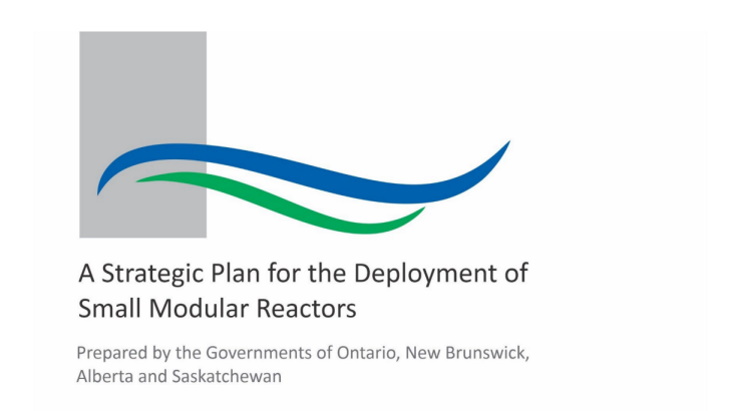The provinces have been working together to advance SMRs in Canada under a Memorandum of Understanding signed by Ontario, New Brunswick and Saskatchewan in December 2019, and which Alberta joined in April 2021. The new report, A Strategic Plan for the Deployment of Small Modular Reactors, is the final deliverable under that MoU.
The 2021 SMR Feasibility Study concluded that SMR development would support domestic energy needs, curb greenhouse gas emissions, and position Canada as a global leader in clean technologies and the fight against climate change. The strategic plan builds on that by identifying key actions that provinces can take to enable a decision on whether to proceed with SMRs. Following a decision to proceed, it outlines further actions to support the deployment of SMRs.
It identifies five priority areas for SMR development and deployment:
- Positioning Canada as an exporter of global SMR technology by propelling three separate streams of SMR development, covering both on-grid and off-grid applications.
- Promoting a strong nuclear regulatory framework that focuses on the health and safety of the public and the environment while ensuring reasonable costs and timelines.
- Securing federal government commitments on financial and policy support for new SMR technologies that would lead to vast economic benefits across the country and help meet emissions reduction targets.
- Creating opportunities for participation from Indigenous communities and public engagement.
- Working with the federal government and nuclear operators on a robust nuclear waste management plan for SMRs.
The three separate streams of SMR technology development envisaged under the plan are:
Stream 1: A grid-scale 300 MWe SMR project to be constructed at the Darlington nuclear site in Ontario by 2028, followed by units in Saskatchewan with the first unit projected to be in service in 2034. Ontario Power Generation (OPG) has announced GE-Hitachi as the preferred technology developer for the Darlington SMR project, and early site preparation works have begun.
Stream 2: Two fourth-generation, advanced SMRs to be developed in New Brunswick: ARC Clean Energy is targeting 2029 for its ARC-100 advanced sodium-cooled fast neutron SMR to be fully operational at the Point Lepreau nuclear site by 2029. Moltex Energy is aiming to have both a used fuel recovery system and Stable Salt Reactor in operation by the early 2030s, also at Point Lepreau.
Stream 3: A new class of micro-SMRs designed primarily to replace the use of diesel in remote communities and mines. Global First Power, a joint venture between OPG and Ultra Safe Nuclear Corporation, is proposing to build a 5 MW micro-SMR at the federally owned Chalk River Laboratories in Ontario, aiming for an in-service date of 2026.
"This Strategic Plan is the final deliverable under the inter-provincial Memorandum of Understanding, but it is only the beginning as the provinces work together to take the next steps to advance SMR innovation in Canada," the report notes. The MoU provinces "will continue to seek opportunities for collaboration on SMR advancement with the federal government to ensure the necessary financial, regulatory and policy supports are in place to support continued SMR development."
"We know the world is watching us when it comes to SMRs and I'm confident that our reputation as a global hub for SMR expertise will only grow stronger from here," Ontario Minister of Energy Todd Smith said. "With job creators looking for affordable, reliable and clean energy, SMRs will enhance our clean energy advantage and help us secure new investments that will create jobs across our province."
Nuclear energy has been a key component of the New Brunswick energy landscape for almost four decades, the province's Minister of Natural Resources and Energy Development Mike Holland said. "It is encouraging to see the private sector get behind these initiatives to help position New Brunswick as a leader in advanced nuclear and clean energy development," he added.
Saskatchewan and Alberta are do not currently have nuclear power reactors. SaskPower - Saskatchewan's principal electricity utility - has laid a strong foundation for nuclear power, Minister Responsible for SaskPower Don Morgan said, citing in particular a four-year collaboration with OPG to assess SMR designs for fleet-based deployment in both Ontario and Saskatchewan.
Sonya Savage, Alberta's Minister of Energy, said there is "great potential" for SMRs to provide zero-emission energy for industrial operations in remote areas and to further reduce emissions from the province's oil sands. "This strategic plan marks another important step forward to determine how to best manage and regulate this innovative technology by working with our provincial partners and federal regulators," she said.





_53514_33880.jpg)


_91467.jpg)





